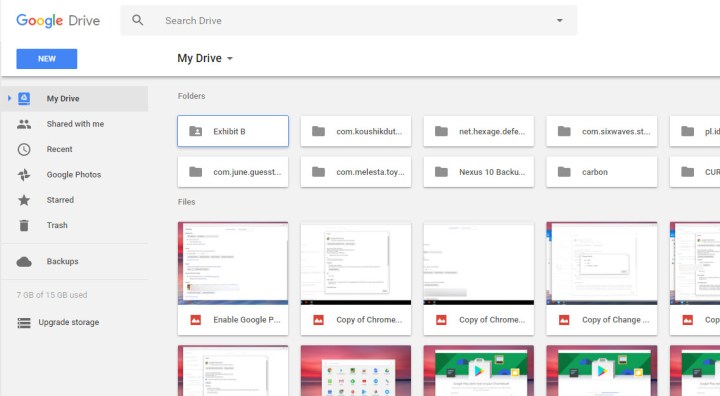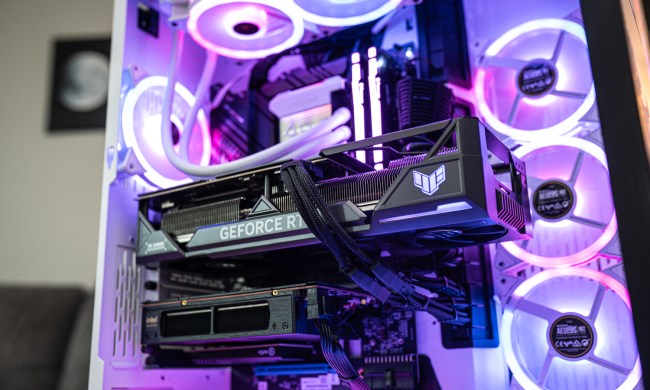
Google Drive and Dropbox are two of the most popular cloud storage providers, if not some of the best. They offer a range of exciting features, from secure file storage and transfer, to free storage, file syncing, extensions, chat-app integration, and more. But while they might go toe to toe on some cloud storage specifications, there are others where one is the clear winner. The question is, which one is the best in 2024?
Let’s take a close look at Google Drive and Dropbox to see how their latest head to head turns out.
Google Drive wins the free storage battle
Both Dropbox and Google Drive offer free storage space for those who would like to try out their respective services before putting down a few dollars a month for something more expansive and permanent. Google Drive comes standard, with 15GB of free space, far more than Dropbox’s initial free storage offering of just 2GB.
Although that does give Google a notable edge in this section, Dropbox offers several ways to increase your free storage. Basic (free) accounts can earn an additional 500MB of storage space for each friend or family member referred to the service, up to 16GB. It also has free trials available for its premium subscription packages, so if you want to try out one of the paid options with masses of storage space, you can for a limited time.
While the additional earned storage space leads to Dropbox offering more free space than Google Drive, referring hoards of friends isn’t a simple task. Especially in today’s world, most people who want cloud storage already have it. It’s good that Dropbox has that option, but ultimately, Google Drive’s free storage is simply better.
For paid storage, it’s a draw between Drive and Dropbox
If you want to store anything beyond a few gigabytes, it doesn’t matter which cloud storage solution you opt for; you’re going to have to pay for it. Both Google Drive and Dropbox offer premium subscription services, giving you much more remote storage, and a range of pricing tiers with different features and, crucially, different quantities of cloud storage.
Dropbox currently offers two sets of plans: One set offers storage and other tools, and the other set offers primarily storage. For the purposes of the guide, we’re only going to focus on the set of Dropbox plans that primarily offer storage. The Dropbox Plus account offers 2TB of storage space, which adds remote device wipe and multi-factor authentication (which is essential for keeping files secure these days). It’ll set you back $120 for the year or $12 a month. There’s also the option of a Professional account, which costs $17 (per month if billed yearly) and offers 3TB of storage space plus watermarking and shared link controls.
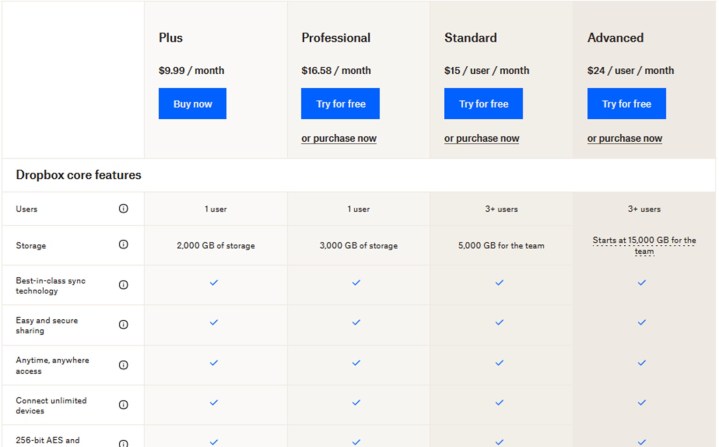
Dropbox also offers Standard and Advanced accounts for teams and business users, including additional file recovery time, viewer history, and device approvals. The Standard accounts are limited to 5TB of storage for a team for $15 per user monthly (when billed yearly). The Advanced subscription used to offer unlimited storage, but has since restricted that to a-still-whopping 15TB for the team. It’s much more expensive, though, costing $24 per user per month when paid annually or $30 per user per month when paid monthly. They also come with a wealth of team management options, including tools such as single-sign-on integrations and tiered admin roles. Dropbox also offers an Enterprise plan, but you’ll need to contact them for pricing.
On the other hand, for personal users, Google Drive simply offers three primary tiers of pricing after the free option, all under its Google One service. The first is called Basic and it’s a $2 per month plan that provides 100GB, access to Google experts, and dark web monitoring. Google’s Standard plan is no longer available, with Google now only offering two further subscription tiers. The next is Premium, which offers 2TB for $10 per month and access to three Google Workspace premium features, as well as cashback in the Google Store and additional features for Google Photo editing.
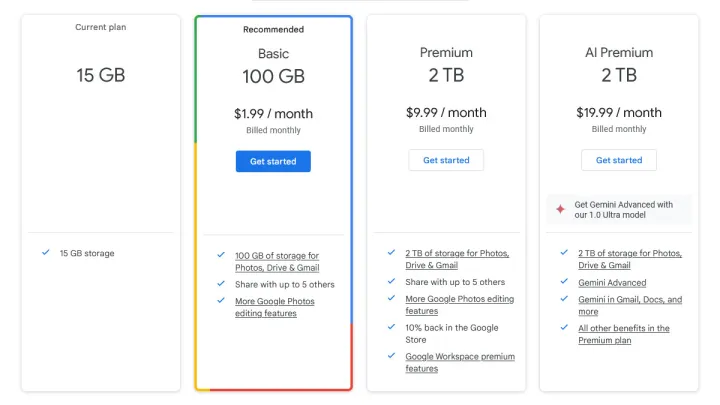
The next higher tier is AI Premium, which offers the same 2TB of storage space, but with additional Google Gemini features, including the latest model at the time of writing, Ultra 1.0
Ultimately, Google Drive and Dropbox both have their advantages when it comes to pricing. If 100GB of space will suffice, Google Drive’s $2 a month option is the best bet. But if you need much more storage due to creative projects or business needs, Dropbox may be the way to go since its paid plans start at $12 per month for 2TB when billed monthly. In this case, it’s a bit of a draw because who wins this category is based on what your exact storage needs are. If it’s more personal, Google Drive’s Google One service might be best. More professional? Dropbox might be the one for you.
For more AI features and integration with Google’s other products? That’s a no brainer.
Dropbox edges out Drive with file syncing
Dropbox can sync files across multiple devices and operating systems, including all primary desktop and mobile platforms. As Cloudwards breaks down in its comparison, its Linux support and “smart-sync” set Dropbox apart from the competition, as it means only changes are synchronized, not the entire file or folder.
In comparison, Google Drive’s syncing supports multiple devices and operating systems, though it doesn’t support Linux natively. Some workarounds make it so, but it’s not an officially supported platform for file syncing. While it does let you select specific files to sync, it doesn’t support syncing of file changes, often called “block-level” synchronization. That means it needs to re-upload or download entire files to sync them.
Dropbox wins again with file sharing
File sharing is of paramount importance to many cloud storage customers, as it makes it much easier to send large files or folders to groups of people.
Google Drive lets you share files and folders using the mobile app or in the web browser interface, with direct links or the option to email access to your trusted share partner. It also offers the opportunity to give viewing and editing permissions to those you share with, letting you customize the power they have. The only downside is that without passwords or expiry dates on those links, they do present a potential security problem if you don’t move your shared files or folders in the future.
Dropbox offers just as much flexibility with designating shared folders and files. However, Professional, Standard, and Advanced account holders can set passwords and expiry dates on links, which help protect your data long-term. You can also set user edit permissions with a Standard or Advanced account.
Dropbox’s share page also makes it easy to see which folders and files you’ve made accessible to others. Ultimately, that, combined with better security protections for user data, makes Dropbox the better choice.
Outside support and productivity options
Google Drive can quickly save and store Gmail attachments and twin stored images with Google Photos, and it makes collaboration easier through Google Docs, Sheets, and Slides. The Google Workspace Marketplace has a variety of third-party apps for Google Drive, giving the cloud storage solution a lot more potential than some of its competitors.
Dropbox has also developed its own products and partnerships. Dropbox has lots of extensions that offer support for various email clients and chat apps (like Gmail and Microsoft Teams, respectively), and allow users to do things like sign documents or send faxes.
Plus, Dropbox has added its apps over the years to compete with Google more directly. That includes Dropbox Paper for creating content and Dropbox Transfer for sending large files securely. Notably, the service also recently released a new Desktop app to assemble all its services into a cleaner interface that makes them more usable and integrates Dropbox more fully with operating system capabilities.
Dropbox has come a long way here and again is more friendly for complex or enterprise-level businesses. Still, it’s also very convenient that Google keeps everything in the Google family. It’s a draw: The winner here ultimately depends on what you need.
Dropbox just barely beats Drive in security and privacy
In a world of post-Snowden revelations and regular hacks of major organizations, ensuring your remote data and privacy are protected is a major consideration for many cloud storage customers.
For its part, Dropbox encrypts your data with SSL/TLS encryption while files are in motion and then to a 256-bit AES standard when at rest. It also offers multi-factor authentication for account access, to prevent unauthorized users from gaining access. Paying customers can also remotely wipe sync files should they lose a relevant device. Version rollback even lets you replace updated files for differing periods of time depending on your package, offering some measure of protection against ransomware.
Google Drive offers comparable security features, though it uses 256-bit AES encryption with files in transit and when at rest. It also supports two-factor authentication and Cloud Identity features for businesses.
Overall, Dropbox has a slight lead here. And that’s largely because it offers more security and accident protection features than Google’s Workspace and One plans and offers clear explanations of those features.
Dropbox wins the tight race
Google Drive and Dropbox have an intense rivalry, each system trying to win more users with excellent free service options or the best new paid upgrades. Despite tough competition, we find that Dropbox is a superior cloud storage system to Google Drive.
That said, there are some cases where Google Drive may better serve your needs. For newcomers to storage systems with limited experience, scarce funds, and little file content, Google Drive is the best option to try out, as it has a free version with a lot more perks than Dropbox. Seasoned Google users will have no problems navigating through and understanding the format of Google Drive. While Google users might prefer what’s familiar to them, we still think Dropbox is the best service.
Business users will find Dropbox especially advantageous because it has features like terabytes of storage in all of its paid plans, robust file syncing and sharing, and a helpful password protection feature for shared files. If you want to use Google’s AI services though, paying a little extra for storage gets you access to some of its latest developments, which are well worth considering.
